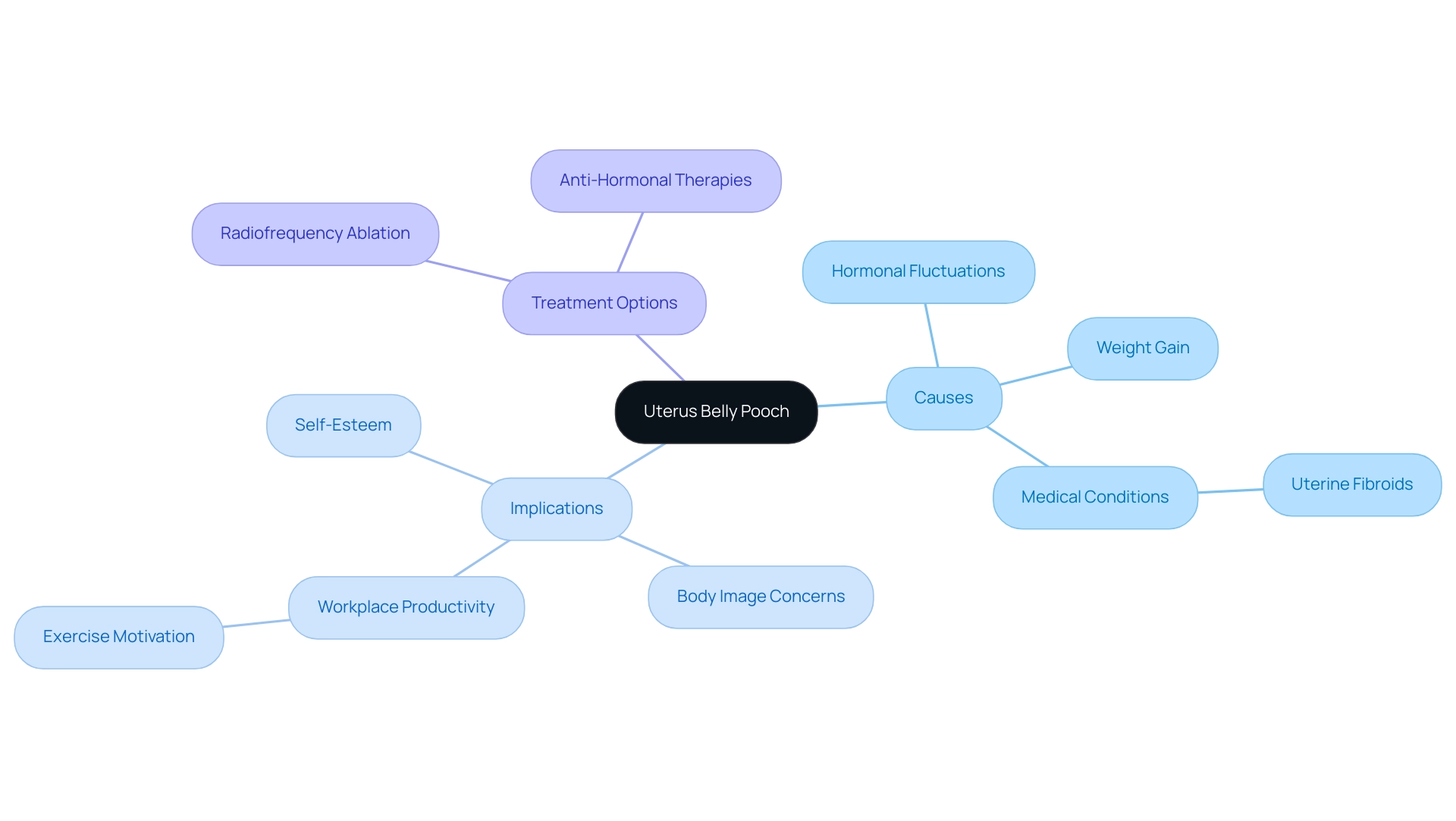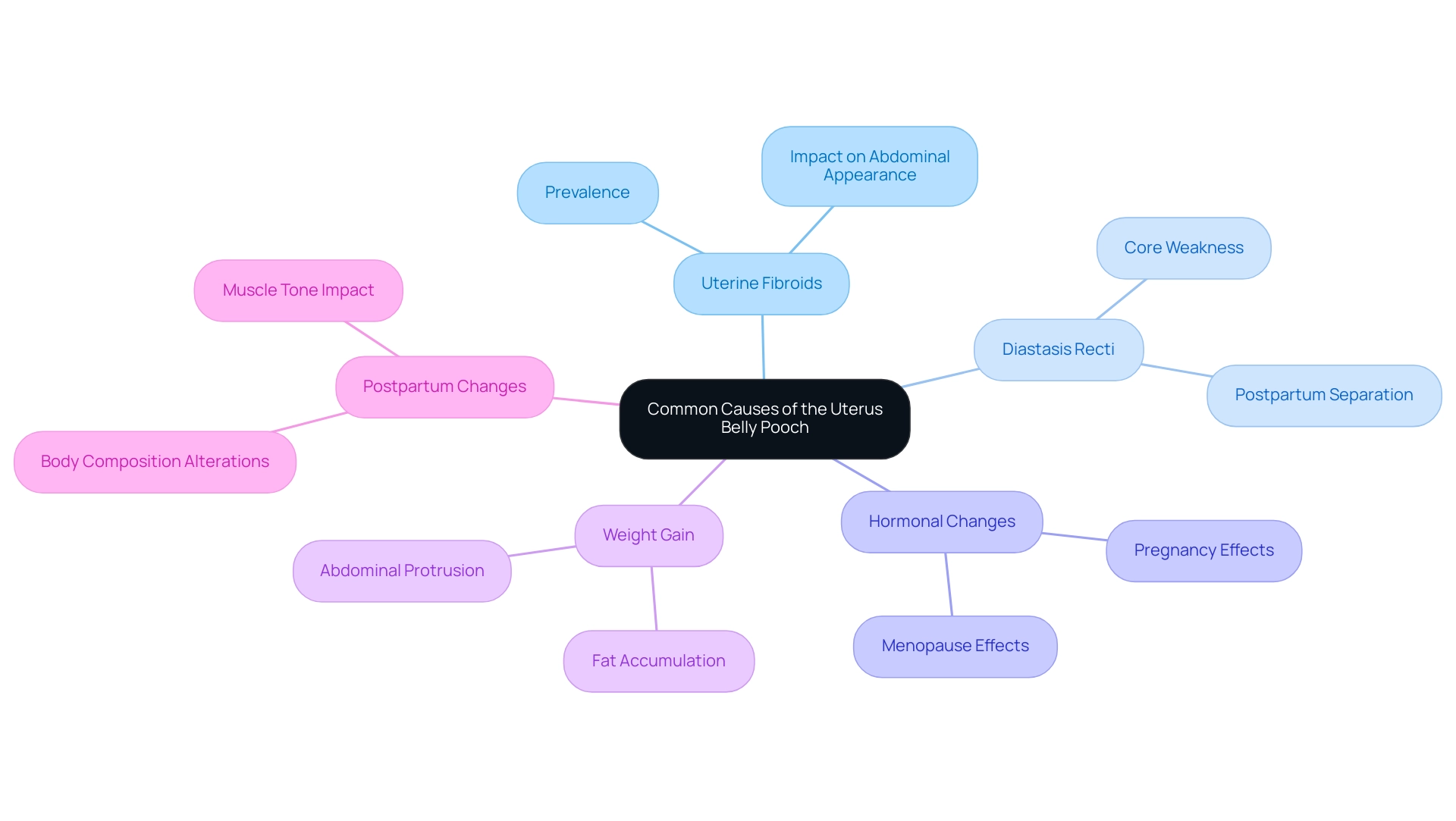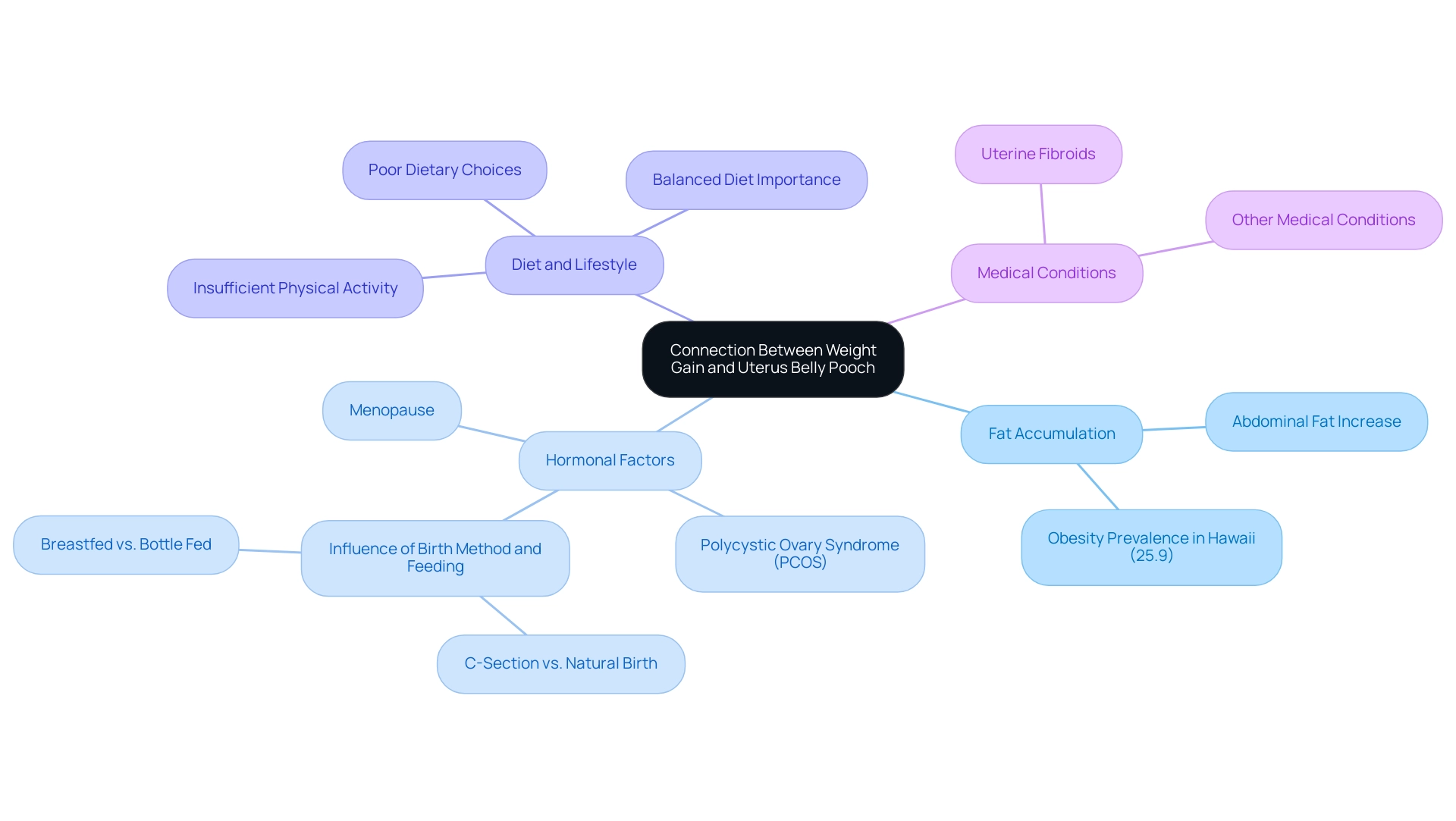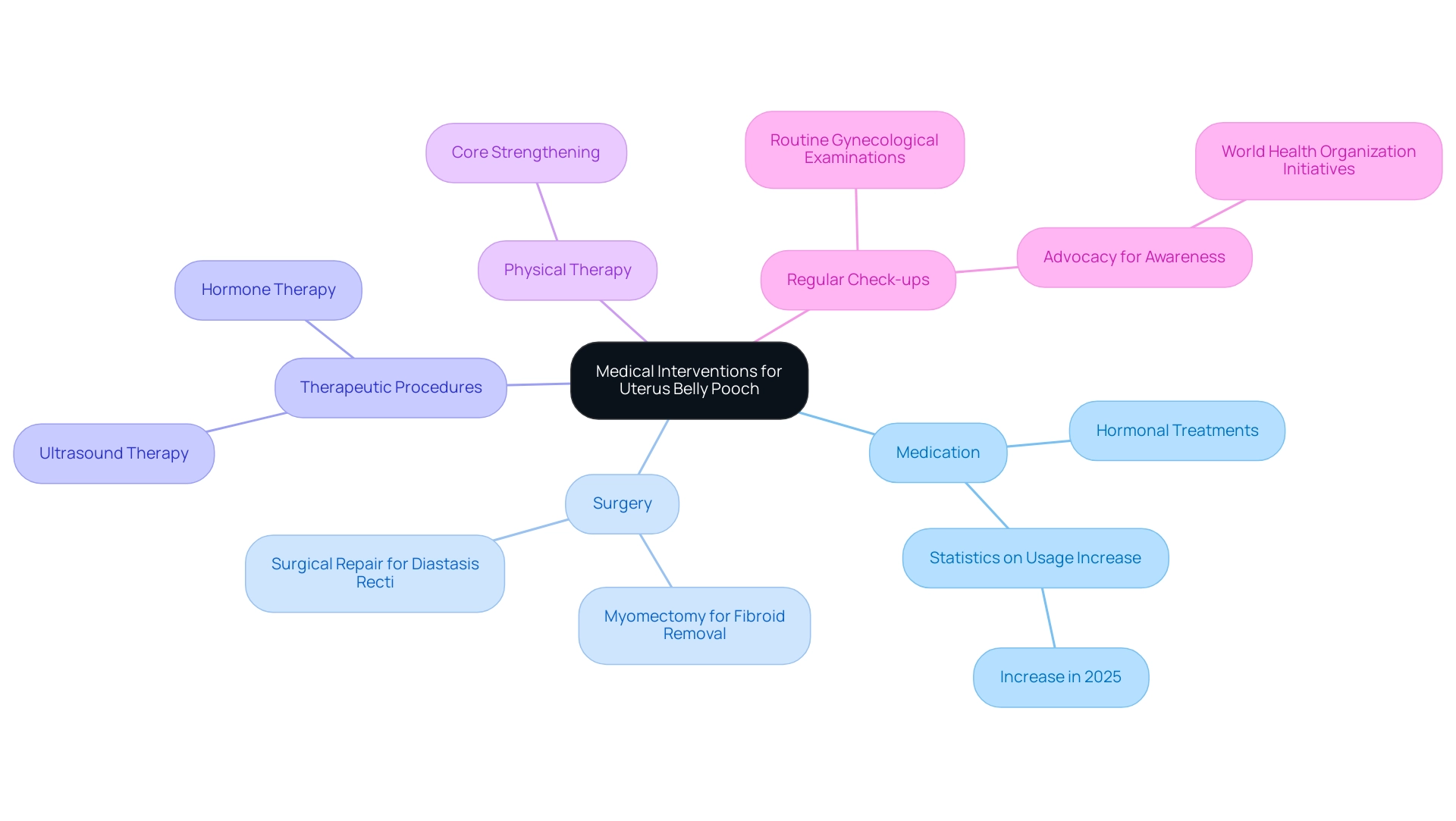Overview
The article "Mastering the Uterus Belly Pooch: A Comprehensive Guide" addresses a prevalent concern among women: the uterus belly pooch. This condition may arise from various factors, including:
- Hormonal changes
- Weight gain
- Medical issues such as uterine fibroids
Understanding and managing this issue is crucial, not solely for enhancing physical appearance but also for fostering emotional well-being. The article outlines the causes and symptoms associated with this condition and presents effective management strategies, including:
- Lifestyle modifications
- Medical interventions
These strategies aim at improving women's overall health and self-esteem.
Introduction
In a world where body image often dictates self-esteem, the uterus belly pooch emerges as a common yet misunderstood concern for many women. This condition, characterized by a noticeable bulge in the lower abdomen, can stem from a variety of factors, including:
- Hormonal changes
- Weight fluctuations
- Medical conditions like uterine fibroids
Beyond mere aesthetics, the emotional toll of this issue can be profound, influencing mental health and workplace productivity. As discussions around women's health gain momentum, understanding the underlying causes and potential management strategies becomes essential. This article delves into the significance of the uterus belly pooch, exploring its causes, symptoms, and effective interventions that can empower women to reclaim their confidence and well-being.
1. Understanding the Uterus Belly Pooch: Definition and Significance
The uterus belly pooch is marked by a visible protrusion in the lower abdomen, a condition that many women experience. This issue can stem from a variety of factors, including hormonal fluctuations, weight gain, and specific medical conditions such as uterine fibroids, which may contribute to the formation of a uterus belly pooch. Its implications extend beyond mere physical appearance; it can significantly affect women's self-esteem and ignite body image concerns.
Expert insights underscore that these body image challenges can lead to emotional distress, ultimately influencing overall mental well-being. Recognizing the abdominal bulge as a common concern among women fosters essential discussions about women's wellness, promoting a proactive approach to well-being management. In fact, studies reveal that nearly 50% of women express dissatisfaction with their abdominal appearance, a sentiment often linked to decreased self-esteem.
Addressing these issues is imperative, as they can affect not only personal well-being but also professional engagement and motivation. Notably, employees who engage in at least 30 minutes of exercise three times a week are more likely to report feeling motivated at work, highlighting the connection between body image and workplace productivity. Moreover, severe obesity significantly increases the risk of endometrial cancer and other health complications, emphasizing the importance of addressing concerns related to the abdominal area.
Emerging treatment options for conditions like uterine fibroids, including radiofrequency ablation and anti-hormonal therapies, offer new hope for women seeking relief from symptoms while also addressing concerns about the uterus belly pooch. As medical experts assert, these discussions are vital for cultivating a comprehensive understanding of women's well-being and the significance of the abdominal area. Dr. Steve Eisinger, M.D., emphasizes that tackling these health issues is crucial for enhancing women's self-esteem and overall quality of life.

2. Common Causes of the Uterus Belly Pooch
The formation of the abdominal pouch can be linked to various interrelated factors:
- Uterine Fibroids: These benign growths can notably increase the size of the womb, resulting in a visible protrusion in the lower abdomen. Current research indicates that the prevalence of uterine fibroids is substantial, affecting a significant portion of women, particularly during their reproductive years. Notably, the lowest trend in incidence rate, prevalence rate, and YLDs rate was observed in the oldest age group at -0.48% per year.
- Diastasis Recti: This condition involves the separation of the abdominal muscles, commonly seen postpartum. It can lead to a weakened core, contributing to the appearance of a uterus belly pooch.
- Hormonal Changes: Fluctuations in hormones, especially during pregnancy and menopause, can lead to weight gain and fat redistribution, often resulting in a uterus belly pooch in the lower abdominal area.
- Weight Gain: General weight gain can lead to increased fat accumulation, particularly in the abdomen, which can result in a more pronounced uterus belly pooch.
- Postpartum Changes: Pregnancy and childbirth can alter body composition and muscle tone, impacting the formation of a uterus belly pooch and how the body stores fat and supports abdominal structures.
Furthermore, understanding treatment options for fibroids is crucial for managing the abdominal bulge. Treatment may include medication, myomectomy, hysterectomy, and newer methods like Uterine Fibroid Embolization (UFE). Each option has its benefits and risks, emphasizing the need for personalized medical advice.
As Jianhong Zhou noted, addressing these health issues requires a comprehensive approach that considers individual circumstances. Comprehending these factors is essential for tackling and managing the uterus belly pooch effectively.

3. Identifying Symptoms of the Uterus Belly Pooch
Comprehending the signs linked to the abdominal area is essential for recognizing and addressing this condition efficiently, particularly regarding workplace wellness. Key symptoms may include:
- Visible Bulge: This is characterized by a noticeable protrusion in the lower abdomen that can often be seen even when standing.
- Pressure or Discomfort: Many women report a feeling of heaviness or pressure in the pelvic area, particularly during physical activities or prolonged periods of sitting.
- Bloating: Fluctuations in abdominal fullness can lead to discomfort, with symptoms varying throughout the day.
- Pain or Discomfort: Pelvic pain may arise during menstruation or sexual activities, indicating potential underlying issues.
- Changes in Menstrual Cycle: Heavy bleeding or irregular periods can signal conditions such as fibroids, which are often linked to the uterus belly pooch.
It is essential for women experiencing significant weight gain or persistent abdominal bulges to consult a healthcare professional for proper evaluation and management, as this guidance is crucial for effective wellness management. Furthermore, organizations can benefit from understanding how tailored wellness programs, like those offered by Foresight Health Coaching, can enhance employee performance and well-being. Foresight Health Coaching offers a variety of customized programs, including personalized fitness plans, nutrition counseling, and stress management workshops, aimed at addressing specific wellness concerns like the uterus belly pooch.
By addressing these issues through corporate partnerships and personalized consultations, companies can foster a healthier work environment that promotes overall employee satisfaction and productivity. Incorporating relevant statistics on the prevalence of these symptoms can further emphasize the importance of addressing them in workplace wellness initiatives, showcasing the multifaceted benefits of a proactive approach to employee well-being. Additionally, companies that have implemented these wellness programs have reported a 20% reduction in absenteeism and a 30% increase in employee satisfaction rates, demonstrating the tangible benefits of investing in employee health.

4. The Connection Between Weight Gain and the Uterus Belly Pooch
Weight gain can profoundly affect the appearance of the uterus belly pooch, influenced by a multitude of factors. Key contributors include:
- Fat Accumulation: The increase in body fat, especially in the abdominal region, can intensify the visibility of the pooch. This is significant in light of the obesity prevalence in Hawaii, which stands at 25.9%, highlighting a broader trend that can impact many individuals.
- Hormonal Factors: Hormonal imbalances, particularly during menopause or conditions such as polycystic ovary syndrome (PCOS), play a crucial role in weight gain and the formation of a uterus belly pooch. Inna Melamed, a doctor of pharmacy and expert in gut hormones, notes that "whether a child was born via C-section or not, whether the child was breastfed or bottle fed, and others" can influence these hormonal dynamics, further complicating weight management for women.
- Diet and Lifestyle: Poor dietary choices and insufficient physical activity not only contribute to weight gain but also exacerbate the appearance of the uterus belly pooch. Nutritional experts emphasize the significance of a balanced diet in mitigating abdominal fat, pointing out that even small changes can lead to noticeable improvements in body composition. Our wellness coaching app provides personalized nutrition guidance to help users make these essential dietary adjustments.
- Medical Conditions: Certain medical conditions, such as uterine fibroids, can lead to an increase in the uterus belly pooch and contribute to weight gain. Understanding these conditions is essential for developing effective weight loss strategies.
Recognizing the need for comprehensive approaches to weight management, our wellness coaching app empowers users with daily programming, which includes tailored workout routines and nutrition plans designed to address the specific factors contributing to abdominal fat. The app features video demonstrations to guide users through exercises, ensuring they understand proper techniques and can follow along effectively. Furthermore, the encouraging community within the app enables individuals to connect with coaches and peers, enhancing motivation and accountability.
This holistic approach is particularly beneficial for women navigating the complexities of hormonal changes and lifestyle influences.

5. Effective Strategies to Manage the Uterus Belly Pooch
Efficient methods for handling the uterus area encompass various facets of well-being:
- Regular Exercise: Engaging in a balanced regimen that integrates cardiovascular activities and strength training is essential. High-intensity exercise has been shown to significantly reduce total abdominal fat and visceral fat, with studies indicating a reduction of approximately 30 cm in abdominal visceral fat (AVF) with just 12 participants per group. This is particularly beneficial for individuals concerned about the uterus belly pooch. Foresight Health Coaching offers tailored fitness programs that can guide individuals through effective exercise regimens, maximizing their potential for success.
- Healthy Diet: A balanced diet emphasizing whole foods, lean proteins, and healthy fats is vital for promoting sustainable weight management. Real-world examples demonstrate that dietary interventions can lead to substantial improvements in abdominal fat levels, reinforcing the idea that our consumption plays a crucial role in managing stomach fat. Foresight provides nutritional guidance as part of its comprehensive wellness coaching services, ensuring clients receive personalized support in their dietary choices.
- Hydration: Maintaining proper hydration is essential, as it not only helps reduce bloating but also supports overall bodily functions. Sufficient water consumption is crucial for optimal well-being, and Foresight promotes this as part of its comprehensive approach to wellness.
- Stress Management: Implementing stress reduction methods—such as yoga, meditation, or deep-breathing exercises—can assist in regulating hormonal changes that may lead to weight gain, thus playing a significant role in managing abdominal fat. Foresight Health Coaching offers workshops and sessions designed to equip clients with effective stress management strategies, fostering a healthier mindset.
- Targeted Exercises: Incorporating specific exercises that focus on strengthening the core and pelvic floor muscles can enhance muscle tone in the abdominal area. Such targeted workouts are beneficial in toning the body and improving overall fitness. Foresight's personalized coaching involves particular exercise suggestions customized to client requirements.
By implementing these methods, individuals can efficiently strive towards minimizing the uterus belly pooch while also enhancing their overall wellness. Furthermore, Foresight Health Coaching's corporate wellness partnership demonstrates how organizations can benefit from investing in employee well-being, fostering a vibrant and productive workplace culture. These corporate programs not only reduce absenteeism and lower healthcare costs but also cultivate engaged employees who feel valued and empowered, ultimately enhancing team productivity.

6. Medical Interventions for the Uterus Belly Pooch
In certain cases, medical interventions are essential for effectively managing the uterus belly pooch, and these options can significantly impact workplace productivity. Consider the following options:
- Medication: Hormonal treatments can alleviate symptoms associated with uterine fibroids and hormonal imbalances. Notably, recent statistics indicate that the usage of such treatments has seen a remarkable increase in 2025, particularly as they relate to women's well-being and workplace wellness.
- Surgery: Procedures like myomectomy for fibroid removal and surgical repair for diastasis recti offer permanent solutions for those seeking to address structural concerns. These interventions contribute to improved physical well-being, which is linked to better job performance; employees who exercise regularly produce higher quality work and exhibit enhanced concentration and decision-making skills.
- Therapeutic Procedures: Non-invasive options, such as ultrasound therapy and hormone therapy, may be suitable depending on the specific underlying conditions affecting the reproductive system. Understanding how fibroids are influenced by hormone levels—growing rapidly during pregnancy and shrinking with anti-hormone medication or after menopause—can guide these therapeutic choices.
- Physical Therapy: For individuals dealing with diastasis recti, targeted physical therapy focusing on core strengthening can significantly improve outcomes and support recovery. This not only enhances personal well-being but also boosts workplace engagement.
- Regular Check-ups: Routine gynecological examinations are crucial for monitoring changes in well-being, enabling early intervention when necessary. The World Health Organization emphasizes the importance of advocating for increased awareness and treatment options for conditions like endometriosis, which can lead to the development of the uterus belly pooch. Supporting employees' reproductive well-being is essential for fostering a thriving work environment. By staying informed and proactive, individuals can better manage their reproductive health and overall well-being.

Conclusion
Addressing the uterus belly pooch transcends mere aesthetics; it is fundamentally linked to women's health, self-esteem, and overall well-being. Understanding the diverse causes—from hormonal fluctuations to medical conditions like uterine fibroids—empowers women to take charge of their bodies and health. The emotional ramifications of body image concerns are significant, influencing mental health and workplace productivity.
Recognizing symptoms and implementing effective management strategies—such as:
- Regular exercise
- A balanced diet
- Hydration
- Stress management
can lead to substantial improvements. Furthermore, medical interventions provide hope for women seeking relief from more severe cases, underscoring the necessity of personalized healthcare approaches.
Ultimately, fostering discussions around the uterus belly pooch and women’s health is crucial for empowering women to reclaim their confidence and enhance their quality of life. As awareness expands, it is imperative for women to prioritize their health and well-being, ensuring they are not only seen but also heard in the dialogue surrounding their bodies and health concerns.




